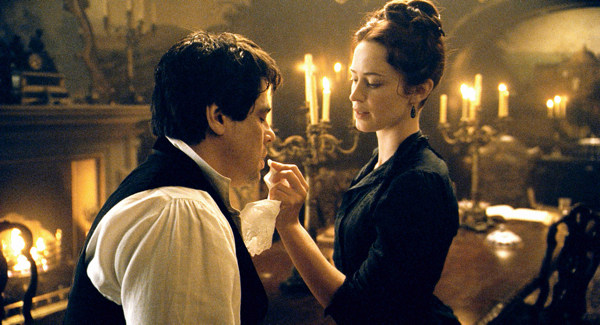Movie review by Greg Carlson
Veteran director/art director/visual effects specialist Joe Johnston makes mincemeat of “The Wolfman,” his remake of the 1941 Universal horror classic that spawned numerous imitators and thousands of nightmares for generations of children who caught Halloween broadcasts on television. Johnston’s version eliminates suspense in favor of brutal shock, which assaults the viewer in scene after scene of abrupt cuts to hapless extras eviscerated on the heath. Dull, repetitious, and gravely serious when it should be howling with midnight black humor, “The Wolfman” will appeal to only the most devoted genre fanatics seeking a lycanthropic fix.
Benicio del Toro assumes the central role of thespian Lawrence Talbot, the soon-to-be cursed prodigal son who returns to his ancestral estate to attend the funeral of his brother, the victim of a gruesome and puzzling murder. Talbot reunites with his moody, cantankerous father Sir John (Anthony Hopkins) and quickly takes a fancy to the aggrieved Gwen Conliffe (Emily Blunt), his brother’s fiancée. Before he can fully investigate the cause of his sibling’s demise, Talbot is attacked and bitten on the neck by a werewolf, and his new affliction consumes all the energy the matinee idol can muster.
It is no coincidence that Talbot has been envisioned as a stage actor interpreting Hamlet, but the obvious, edgeless screenplay by Andrew Kevin Walker and David Self stops short of the deep self-reflection undertaken by the melancholy Dane. Instead, “The Wolfman” lopes along in a repetitious cycle of action sequences, expository flashbacks, and Talbot’s psycho-dramatic confrontations with Sir John and Gwen. Anyone paying attention will suspect immediately that Sir John is not exactly what he seems, and the Oedipal undertones of the story divert any intrigue that might arise from Talbot’s man/beast struggle toward a forgettable werewolf versus werewolf brawl that sets up the film’s conclusion.
Once Talbot’s monthly metamorphosis has been established, Johnston jettisons the mystery procedural in favor of the equally well-worn chase structure, as a constabulary led by Scotland Yard’s humorless Inspector Aberline (Hugo Weaving, neglected and misused) hunts the doomed Talbot. Following his initial confinement to a horrific insane asylum, Talbot disproves the hospital’s smug physicians by painfully busting through the leather straps that confine him. The tiered operating theatre, heavily peopled by curious doctors, calls to mind images like Rembrandt’s “The Anatomy Lesson of Dr. Nicolaes Tulp” as well as a famous scene in “King Kong,” and is the only memorable moment in an otherwise dreadful slog.
Del Toro plays his part arrow-straight, and Hopkins climbs all over the furniture, but Emily Blunt somehow capitalizes on the thankless “love interest” role. Maintaining dignity well beyond the measure offered her character in the script, Blunt proves more interesting than any of the hairy, fanged brutes whose company she keeps. A final-scene suggestion that the lupine curse has been passed to someone else follows the rules of bijou cliché, but sadly, Blunt is not the recipient of the fateful wound that makes new mutants. That’s a pity, since the prospect of Ms. Blunt as the She-Wolf of London sounds infinitely more thrilling than anything that transpires in the dreary and ponderous sludge presented by Johnston.
